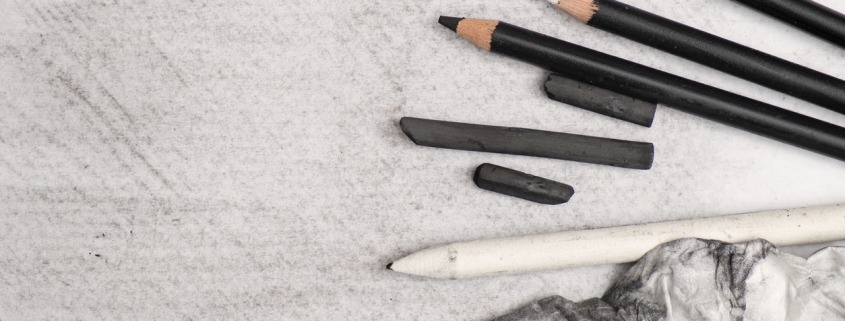Drawing Tools for Beginners
BY: Arleen Mariotti
We can draw with pencils, pens, and markers. But most drawing classes will start you with pencils. Which pencil, you ask? And what other materials will you need if you want to start drawing?
1. Graphite Pencils
If you are an aspiring artist, pick up a pack of real art pencils rather than working with the familiar #2. These pencils usually do not have erasers at the end. You can buy individual pencils or a set of pencils. Pencil sets are great because they often include the full range of graphite grades.
Pencils are labeled according to their graphite “power.” Harder graphite (H) makes lighter marks and keeps a sharp tip longer. Softer graphite (B) makes a darker mark but needs constant sharpening. These sets give the artist the ability to work with many different values and varieties of marks.
Grades of drawing pencils are organized on a scale based on softness or hardness. An “HB” pencil (our familiar #2) is found directly in the center of the scale.

The number found in front of the letter reveals just how soft or hard the pencil is. In other words, a “4H” pencil is harder than a “2H” pencil while a “4B” pencil is softer than a “2B” pencil.
Harder pencils produce lighter marks since less of the material is released as pressure is applied. Softer pencils make darker marks. Therefore, a “4H” pencil will produce lighter marks than a “2H” pencil while a “4B” pencil will make darker marks than a “2B” pencil.
The sharpness of the pencil tip can also depend on the angle at which you hold the instrument and the amount of pressure you apply.
2. Erasers
Erasers are for mistakes – right? Think again. Erasers can be a great mark-making tool as well. There are three types you should consider:
Kneaded Eraser – This eraser lifts material from the surface, instead of using friction to remove it. You can pull and fashion it into different forms to create specific marks. This eraser gets dirty over time, but you can clean it by pulling and “kneading” it.
Plastic erasers remove lead easily with little pressure. They usually do not produce smudges, tears, or ghosting (the presence of a faint image). High quality, latex-free erasers do not harden with age. They can erase almost anything but can tear the paper if you’re not careful.
Electric erasers (or battery-operated) have an eraser-tube that rotates at the push of a button. This makes them extremely powerful at erasing, but the small size of the eraser allows you to erase tiny details. Artists often have to make pinpoint erasures and treat an eraser similar to a pencil. Creating whitespace with precision is just as important as adding new marks to a page.
3. A Decent Pencil Sharpener
A sharp point needs a quality pencil sharpener. While an electric pencil sharpener has its appeal, a manual pencil sharpener will do for most of us.
4. Blending Tools – Stumps and Tortillons
One of the must-have tools for drawing is smudging tools. A popular smudging tool is a blending stump. It can not only help in blending the different effects of a pencil, but you can also use it to add texture to your pencil marks.
5. A ruler
A transparent ruler is a nice tool to draw straight lines, but any straight edge will do.
6. A Sketchbook
A sketchbook is probably one of the most important tools an artist has. An artist practices his/her drawing skills daily on a sketchbook. Although people may not see your sketchbook, the art you create in your sketchbook can increase your skill and creativity.
You can use copy paper, but it should be of a heavier weight paper than regular printer paper (20lb). Using a thicker paper allows you to draw confidently without fear that your marks will indent on the next page. Heavier paper also gives you the ability to rub and smudge the graphite for shading and blending without the page wrinkling or tearing.
You can get sketchbooks that are either glue- or spiral-bound. The glue-bound books look like a traditional book and line up nicely on the shelf. Spiral-bound sketchbooks can be flipped open for a flat, sturdy surface.
You are now ready to draw with just four things: graphite pencils, an eraser, a sharpener, and some paper.





Leave a Reply
Want to join the discussion?Feel free to contribute!